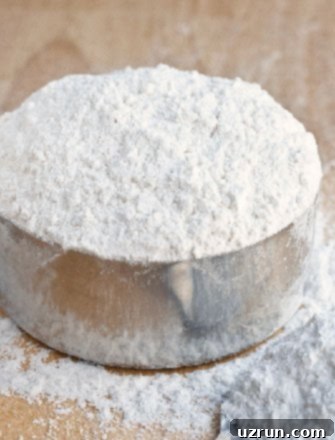Unlock Perfect Baked Goods: Your Easy Guide to Homemade Cake Flour with Just 2 Ingredients
Achieving that delicate, tender crumb in your cakes and cupcakes often hinges on one crucial ingredient: cake flour. But what if you don’t have any on hand, or prefer a budget-friendly, readily available alternative? Good news! You can effortlessly create a high-quality homemade cake flour substitute using just two common pantry staples: all-purpose flour and cornstarch. This simple trick is a game-changer for any baker, ensuring your desserts always come out light, airy, and beautifully soft.
Forget the special trip to the store and the extra expense of specialty flours. This quick and easy substitute allows you to harness the power of ingredients you likely already have, saving you time and money. It’s also an invaluable recipe to have in your baking arsenal for those moments when you unexpectedly run out of your favorite flour. Elevate your baking game and create professional-quality desserts right from your kitchen.
For more helpful baking insights and essential kitchen hacks, be sure to explore our guides on How to Blind Bake Pie Crust and How To Make Brown Sugar.
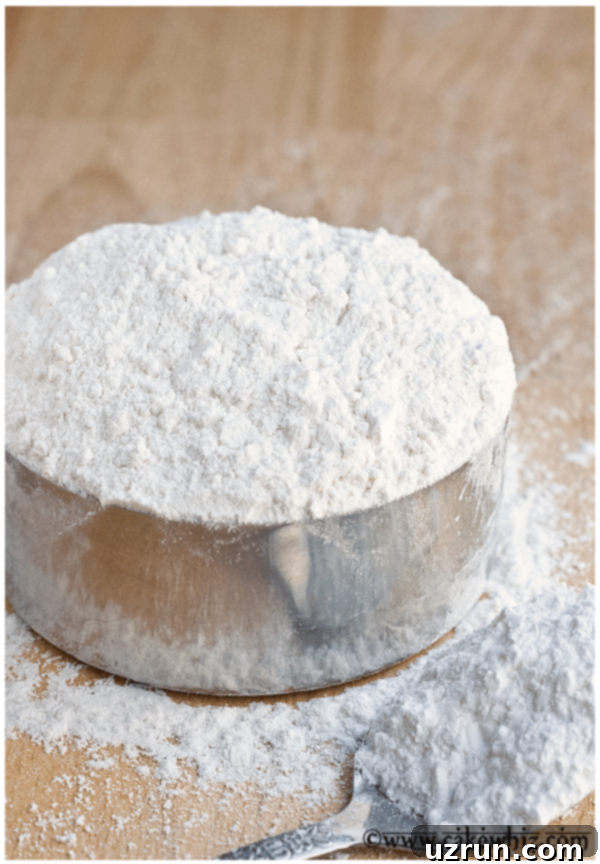
What Exactly is Cake Flour? Understanding Its Unique Role in Baking
Cake flour is a finely milled flour characterized by its significantly lower protein content compared to other flours, typically ranging from 7% to 8%. This low protein level is the secret behind its exceptional performance in delicate baked goods. When you mix a batter, the proteins in flour develop gluten, which gives structure and chewiness. For breads, this is desirable. However, for cakes, less gluten means a softer, more tender, and crumbly texture that simply melts in your mouth.
This type of flour is engineered to create a wonderfully firm yet exceptionally soft texture, making it the preferred choice for professional bakeries crafting high-quality, melt-in-your-mouth desserts. Its unique composition helps prevent the cake from becoming tough or dense, ensuring a light, airy, and fluffy result every single time.
Why Make Your Own Cake Flour Substitute? The Benefits of DIY
There are several compelling reasons why making your own cake flour is a smart move for any home baker:
- Cost-Effective: Store-bought cake flour can be more expensive than regular all-purpose flour. By making it at home, you save money while still achieving premium results.
- Always Available: No more last-minute runs to the grocery store! As long as you have all-purpose flour and cornstarch, you can whip up cake flour whenever inspiration strikes or an unexpected baking craving hits.
- Freshness Guaranteed: You control the ingredients and the preparation, ensuring you’re always using the freshest possible flour blend for your baking.
- Emergency Solution: Ran out of cake flour mid-recipe? This substitute recipe is a lifesaver, allowing you to continue baking without interruption.
- Perfect Texture: This homemade blend mimics the properties of commercial cake flour, guaranteeing that light, tender, and airy texture essential for exquisite cakes and cupcakes.
How to Make DIY Cake Flour Substitute from Scratch: A Simple 2-Ingredient Method
Creating your own cake flour is surprisingly simple and requires only two ingredients you likely already have in your pantry. The key to success lies in precise measurement and thorough sifting.
- Measure Out All-Purpose Flour: Begin by precisely measuring 1 cup of all-purpose flour. For accurate baking, always spoon your flour into the measuring cup and then level it off with a straight edge, rather than scooping directly from the bag. This prevents compacting the flour and ensures you have the correct amount.
- Remove a Portion of Flour: From your measured cup of all-purpose flour, carefully remove 2 tablespoons. Return this removed flour to your all-purpose flour bag. This step is crucial because it reduces the overall protein content of your flour, mimicking the lower protein levels found in commercial cake flour.
- Add Cornstarch: Now, add 2 tablespoons of cornstarch into the cup of all-purpose flour. Cornstarch is a pure starch and contains no protein, thus effectively diluting the protein content of the all-purpose flour. This reduction in protein is what ultimately leads to less gluten formation and a more tender baked good.
- Sift Thoroughly: This is arguably the most critical step. Sift the flour and cornstarch mixture a total of five separate times. Sifting multiple times isn’t just about mixing; it’s about aerating the flour and evenly distributing the cornstarch throughout. This process breaks up any clumps, creates a finer texture, and ensures that the cornstarch is perfectly integrated, which is essential for uniform gluten reduction and a consistently tender result in your baking. Don’t skip or skimp on this step – it makes all the difference!
See what I mean? You only need 2 ingredients to make this transformative baking staple!
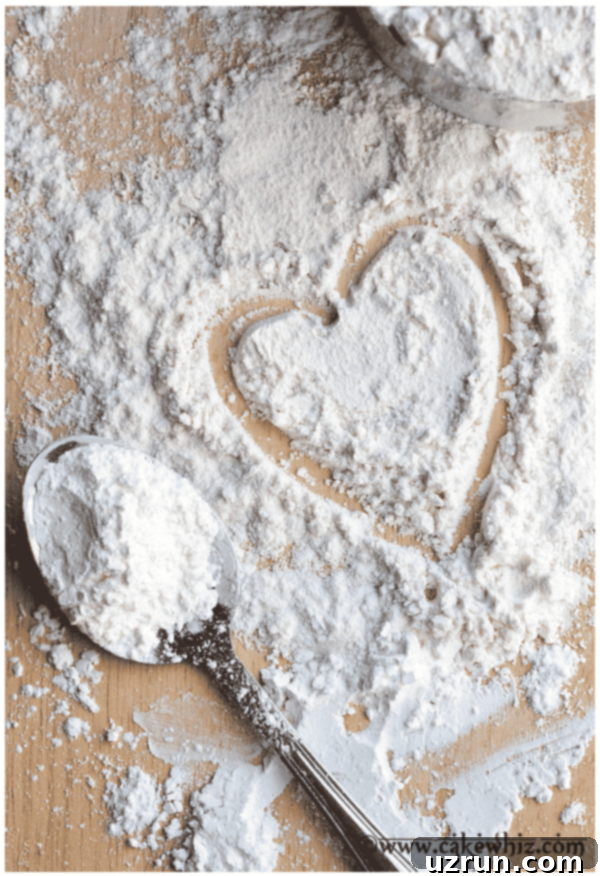
Cake Flour vs. All-Purpose Flour vs. Pastry Flour: Understanding the Differences
When it comes to baking, not all flours are created equal. The primary distinguishing factor between different types of flour is their protein content, which directly influences how much gluten develops when mixed with liquid.
- Cake Flour: As discussed, cake flour boasts a low protein content, typically around 7%-8%. This minimal protein translates to less gluten formation, resulting in an exceptionally light, airy, tender, and fluffy texture. It’s the go-to for delicate baked goods like sponge cakes, chiffons, and fine cupcakes.
- All-Purpose Flour: This is your versatile, everyday flour, with a moderate protein content ranging from 10%-12%. It’s designed to be suitable for a wide variety of baked goods, from cookies and muffins to some breads and pies. While it’s a good all-rounder, its higher protein content compared to cake flour would make cakes denser and less delicate if used as a direct substitute without modification.
- Pastry Flour: Falling between cake flour and all-purpose flour, pastry flour has a protein content of about 9%. It’s a high-quality, fine-textured flour that provides a tender crumb, but with a bit more structure than cake flour. As its name suggests, it’s excellent for pastries, pie crusts, biscuits, and some cookies where you want tenderness but also a slight chew or crispness.
The lower protein in cake flour means less gluten is formed as the batter is mixed. Gluten strands are what give dough its elasticity and chewiness. In cakes and cupcakes, we aim for tenderness, not chewiness. By reducing gluten, cake flour (or its homemade substitute) ensures your baked goods are incredibly soft and light.
Optimal Uses for Homemade Cake Flour
This homemade cake flour substitute is ideal for any recipe where a light, delicate, and tender crumb is paramount. I’ve personally used this blend in many of my favorite recipes, where the goal was to create a cake or cupcake that perfectly balances with a rich frosting or filling. For instance, I’ve used this flour in my Chocolate Raspberry Mousse Cake and this Funfetti Cake (Confetti Cake). It also works wonders for light and fluffy cupcakes such as these Yellow Cupcakes, these classic Red Velvet Cupcakes, and of course, irresistible Chocolate Chip Cupcakes.
In all these cases, the main component of the dessert needed to be inherently light to provide a harmonious contrast to a heavier, more decadent frosting or topping. Using this type of low-protein flour helps to achieve that perfect balance between airy cake and rich adornments.
In general, this flour is highly preferred for cakes, cupcakes, and small tea cakes, which typically benefit from being fluffier and softer than other desserts. Conversely, it is generally NOT used to bake items like breads, most cookies, or muffins, which are meant to have a denser, chewier, or heartier texture where higher gluten development is often desired.
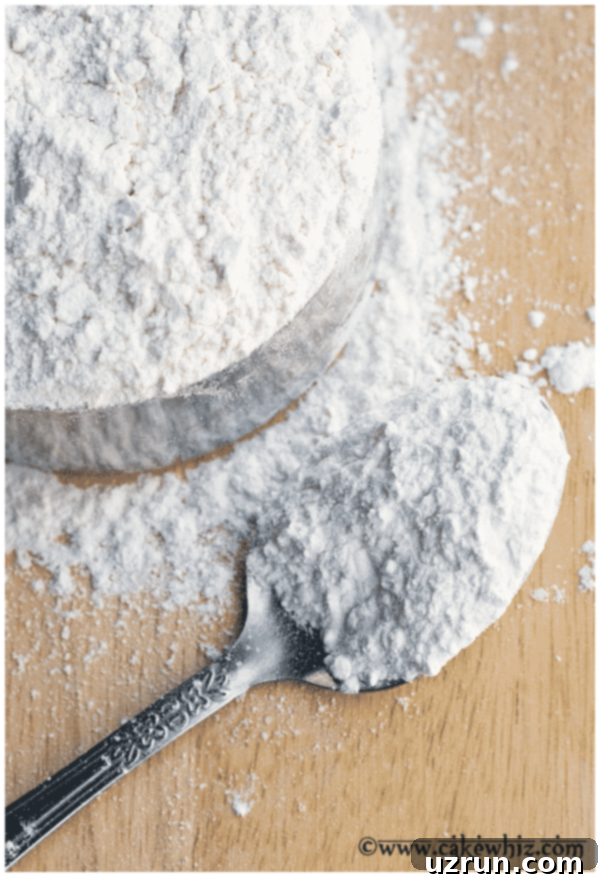
Can I Use All-Purpose Flour to Directly Replace Cake Flour?
No, these two flours are not interchangeable without modification, and doing so will significantly impact the outcome of your recipe. As we’ve explored, all-purpose flour has a higher protein content. If you use it directly in a recipe calling for cake flour, your desserts will turn out much denser, heavier, and potentially tougher. The increased gluten development from all-purpose flour would lead to a less desirable texture for delicate cakes, rather than the light, tender result intended by cake flour.
This is precisely why our homemade substitute recipe is so valuable: it modifies all-purpose flour to mimic the properties of cake flour, allowing you to achieve the desired tender crumb even when you don’t have the specialty flour on hand.
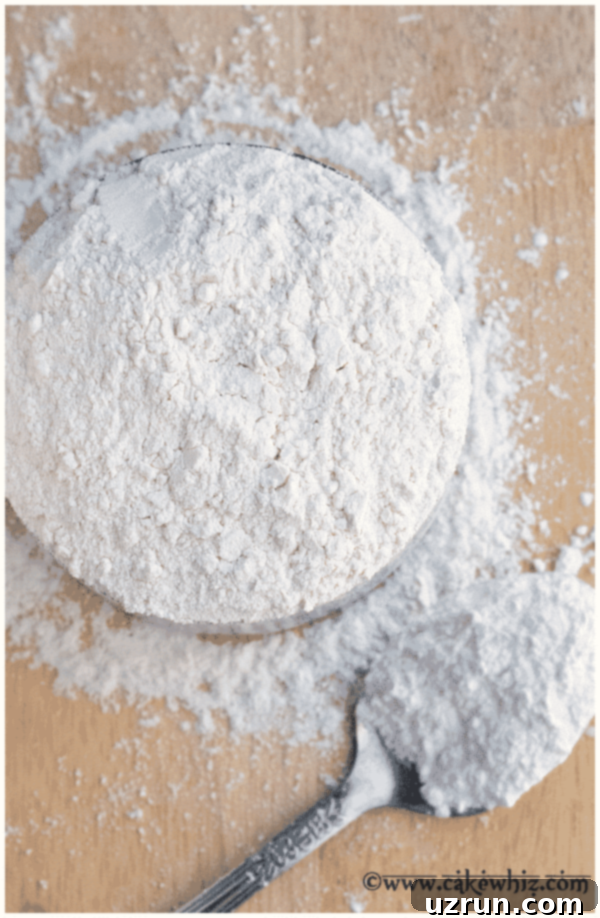
Essential Tips and Techniques for Homemade Cake Flour Success
To ensure your homemade cake flour substitute performs its best, keep these expert tips in mind:
- The Key is Thorough Sifting: We cannot stress this enough! Sifting the two ingredients multiple times (five, to be exact) is absolutely crucial. This isn’t just about mixing; it’s about aeration and even distribution. Sifting incorporates air, making the flour lighter, and ensures that the cornstarch is perfectly blended with the all-purpose flour. This even blend is vital for uniformly reducing gluten formation and achieving that signature tender crumb.
- Make More for Future Baking: This recipe is incredibly easy to scale up. You can easily double or triple the quantities to prepare a larger batch of cake flour. Since it boasts a long shelf life, having a ready supply means you’re always prepared for impromptu baking sessions.
- Don’t Forget to Remove Flour First: This is a common mistake that can derail the entire process. Remember, the foundation of this substitute is *reducing* the protein content of all-purpose flour. You must remove 2 tablespoons of all-purpose flour for every cup you start with *before* adding the 2 tablespoons of cornstarch. Forgetting to omit the flour means you’re just adding cornstarch to a full cup of high-protein flour, which will not yield the desired low-protein cake flour effect.
- Store in a Tightly Sealed Container: Proper storage is key to maintaining the freshness and effectiveness of your homemade cake flour. Always store it in an airtight container or a heavy-duty zip-top bag. This will protect the flour from humidity, moisture, and any unwanted odors or pantry pests, keeping it fresh and ready for baking much longer.
- Measuring Flour Correctly: For the most accurate results, always spoon your all-purpose flour into the measuring cup lightly, then level it off with a straight edge (like the back of a knife). Scooping directly from the bag can compact the flour, leading to you inadvertently using too much, which can affect the final texture of your cake.
- Where to Buy Cake Flour (If You Prefer): If you ever decide to purchase cake flour instead of making it at home, you can typically find it in the baking aisle of almost all major grocery stores. You can also conveniently order it online. Two popular and highly regarded brands that many bakers, including myself, have used and recommend are Swans Down and King Arthur.
Storage Guidelines for Homemade Cake Flour
Proper storage ensures your homemade cake flour remains fresh and effective for an extended period.
- Room Temperature: Store your homemade cake flour in a tightly sealed, airtight container in a cool, dark, and dry place, away from any sources of humidity. When stored correctly, it can last for up to 4-6 months. Be mindful that very humid climates might slightly reduce its shelf life.
- Fridge: For even longer storage, place your sealed container of cake flour in the refrigerator. This can extend its freshness for up to 1 year. Ensure it’s away from any potential liquid spills or strong-smelling foods, as flour can absorb odors.
Expand Your Baking Skills: More Helpful Tips
Continue your baking journey with these additional tips designed to help you master various techniques and create stunning desserts:
- How to Frost a Cake Smoothly
- How to Color Fondant
- How to Make Homemade Sprinkles
- How to Soften Brown Sugar
- How to Frost a Cake Smoothly
Recipe
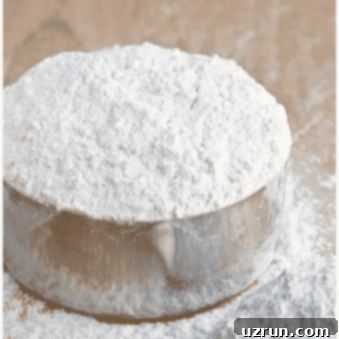
Homemade Cake Flour Substitute
Abeer Rizvi
Pin Recipe
Want to Save This Recipe?
Enter your email & I’ll send it to your inbox. Plus, get great new recipes from me every week!
By submitting this form, you consent to receive emails from CakeWhiz
Ingredients
- 1 cup All-purpose flour
- 2 tablespoons Cornstarch
Instructions
-
Measure out 1 cup of all-purpose flour using the spoon-and-level method for accuracy.
-
Carefully remove 2 tablespoons of all-purpose flour from your measured cup and return it to your flour bag.
-
Now, add 2 tablespoons of cornstarch into the cup of all-purpose flour.
-
Sift the flour and cornstarch mixture a total of five times to ensure even distribution and aeration. This is crucial for a light, tender result.
Notes
- Don’t skip the sifting! This step is essential for incorporating air and evenly distributing the cornstarch.
- Store your homemade cake flour in a sealed, airtight container away from humidity at room temperature for up to 4-6 months, or in the fridge for up to 1 year.
- This recipe can easily be doubled or tripled to make larger batches for future baking needs.
Nutrition
Carbohydrates: 109g
Protein: 12g
Fat: 1g
Sodium: 3mg
Potassium: 133mg
Fiber: 3g
Calcium: 19mg
Iron: 5.8mg
An automated tool is used to calculate the nutritional information. As such, I cannot guarantee the accuracy of the nutritional information provided for any recipe on this site.
Mastering the art of homemade cake flour opens up a world of baking possibilities. With just two simple ingredients and a little sifting, you can consistently achieve the light, tender, and delicate texture that truly elevates your cakes and cupcakes. This practical kitchen hack not only saves you money but also ensures you’re always prepared to bake something extraordinary. Happy baking!
